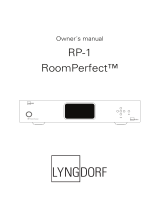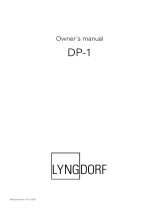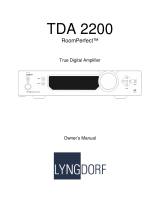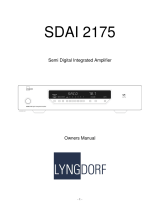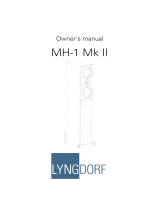Page is loading ...

Owner´s manual
DPA-1
RoomPerfect™
MENU
ENTER
MUTE
ANALOG
DIGITAL
DPA-1 Digital Pre-Amplifier

2

3
Table of Contents
Operating Voltage 4
Unpacking the DPA-1 4
Serial Number Registration 4
Introduction 5
Accessories 6
Front Panel 7
Display Indicators 8
Rear Panel 8
Remote Control 10
Connecting the DPA-1 12
- Connecting to sources and amplifi ers 12
- Using Main and Line outputs 13
Menu System 14
- Navigating the Menu System 14
Menu Tree 15
Introduction to RoomPerfect™ 16
- Global Listening 16
- Focus Listening 16
- Voicing 16
RoomPerfect™ 17
- Guided Setup 17
- Setting the Measurement Volume Level 18
- Focus Measurement 19
- Room Measurements 19
- Adding more Room Measurements 20
- Calculation of Focus 1 and Global Filters 21
- Advanced Options 22
- Measure Focus Pos. 22
- Measure Room Pos. 22
- RoomKnowledge 23
- RoomCorrection 23
Display 24
- Display Timeout 24
- Disp. Brightness 24
- Volume Disp. Timeo. 24
Volume 25
- Def. Vol. 25
- Max. Vol. 25
Input Name 26
Input Sensitivity 26
Advanced Setup 27
- Communication 27
- Comm Address 27
- Comm Speed 27
- Master/Slave 27
- Digital Out 27
- Main Out 28
- Main Out Control 28
- Main Out Level 28
- Line Out 28
- Line Out Control 28
- Line Out Level 28
- Routing 29
- Crossover Frequency 29
- Filter Type 30
- Delay 30
- Trigger Setup 31
- Remote Control 31
- Firmware Versions 31
- Factory Reset 31
RoomPerfect™ Troubleshooting 32
Firmware Upgrading 33
Connectors 34
- Mains Connector 34
- Trigger Connector 34
- Optional AD Converter Board 34
- Balanced Inputs 34
- Unbalanced Inputs 34
Cleaning and Maintenance 34
Technical Specifi cations 35
- Audio 35
- Protection 36
- Mains 36
- Trigger 36
- Mechanical 36
Technical Assistance 37
Appendix 38
- Voicing Curves 38
Manual version 14-05-07

4
Operating Voltage
The DPA-1 can be switched between 115V and 230V mains voltage.
In 115V mode the DPA-1 requires a mains voltage of 100V-120V at 50-60Hz.
In 230V mode the DPA-1 requires a mains voltage of 220V-240V at 50-60Hz.
The mains voltage setting for your DPA-1 can be changed on the rear selector.
Make sure the rear selector is in the correct setting and connect the power input
only to the appropiate AC source. The warranty will not cover any damage caused
by connecting to the wrong type of AC mains.
The DPA-1 has three power modes:
OFF
No circuitry is powered. Please note that some parts of the mains entry section still carry live mains.
STANDBY
The microprocessor is active.
ON
All circuits are active.
Unpacking the DPA-1
Carefully remove the unit and accessory kit from the carton, visually check for shipping damage.
Contact both the shipper and your Lyngdorf Audio representative immediately if the unit bears any sign
of damage from mishandeling. All Lyngdorf Audio equipment is carefully inspected before leaving our
factory.
Keep shipping carton and packing material for future use or in the unlikely event that
the unit needs servicing. If this unit is shipped without the original packing, damage
could occur and void the warranty.
Serial Number Registration
Please record the serial number of your DPA-1 here for future reference. The serial number is printed
on the label on the rear panel. You will need this serial number, should you ever require service for your
DPA-1.
DPA-1 serial number: _____________________
1.
2.
3.

5
Introduction
Congratulations on the purchase of your Lyngdorf Audio DPA-1 with RoomPerfect™.
Besides being a state-of-the-art pre-amplifi er, it also enables you to take advantage of the most advanced
room correction system on the market. It is implemented in such a way that you will always achieve the
perfect result. No computer needed, no acoustic knowledge needed, no user input needed. We leave
nothing to chance in the fully automated calibration process.
However, for the advanced user there are plenty of challenges since the DPA is also a complete ‘Control
Centre’ that allows you to build advanced multi-way passive or active speaker systems. This is possible
due to the very powerful built-in DSP ‘engine’ which facilitates signal routing, creation of active cross-
overs, delay settings etc.
In fact we believe it to be the most versatile pre-amplifi er on the market today, a true state-of-the-art
device that sets new standards for what’s sonically possible to achieve in a real life environment.

6
Accessories
You should fi nd the following accessories included:
1
2 3
4
5
6
7
digital
info
analog
A/B
random
repeat
AMP
channel
ENTER
volume
RCS CD
TUNER
menu
8
0
9
Mains cord 8 m (26.25 feet)
XLR – XLR cable
Microphone
Programming cable
Remote control
Microphone stand with Mic clamp
(delivered in a separate carton)

7
Front Panel
Controls
The buttons/controls on the front panel of the DPA-1 can all be operated either with direct presses or by
operating the corresponding keys on the supplied remote control. All the keys on the front panel (except
the Mains Switch) are duplicated onto the remote control as well.
1. Mains Switch
Powers the DPA-1 on/off.
2. Mute
Toggles Mute mode on/off.
Pressing the Mute button for 3 seconds will set the DPA-1 in stand-by mode.
3. Analog Input Selector
Changes to Analog input, or if already selected, cycles to the next Analog input.
In standby mode, press to turn On the DPA-1 with the last selected analog input.
4. Digital Input Selector
Changes to Digital input, or if already selected, cycles to the next Digital input.
In standby mode, press to turn On the DPA-1 with the last selected digital input.
5. Display
Display with all information on the menu system, status, active input selection and volume control.
6. Volume Wheel
Optical encoded volume control wheel.
7. Navigation Keys
In stand by mode, press Enter to turn On the DPA-1 with the last selected input.
In normal operation mode the Up/Down toggles between bypass and the available Focus and Global
fi lters. The Left/Right keys toggles between neutral and the available voicings.
In menu mode the keys are used for navigation in the menu system: Up/Down, Left/Right & Enter. Press-
ing and holding down the Up/Down, Right/Left keys, changes selected values fast.
8. Menu Button
Toggles Menu mode on/off
12 34 5 6 7 8
MENU
ENTER
ANALOG
DIGITAL
DPA-1 Digital Pre-Amplifier
MUTE

8
Display Indicators
D
A
12345
123 45
1. A-D
Illuminates to indicate whether the active input is Analog or Digital.
2. Menu
Alphanumeric Display (2*20 Characters).
3. 1-5
Illuminates the active input.
4. RoomPerfect Logo
Is illuminated when a fi lter is active.
5. Volume Display
3 digits indicating Volume control setting from 00.0 to 99.9 – in dB’s.
Mute is indicated by the Volume control setting ‘---’.
Standby mode is indicated with the decimal dot from the volume indicator being lit only.
Rear Panel
6 7 8 10 139 11 12
1 52 34
100-120V~/ 220-240V~
~50-60Hz 35W
1. Analog Input 1-3
Unbalanced/RCA Left/Right Analog input pairs
2. Analog Input 4
Balanced/XLR Left/Right Analog input
3. Analog Output
Double pair of balanced/XLR Left/Right analog outputs (Main and Line out).
4. Analog Output
Double pairs of unbalanced/RCA Left/Right analog outputs (Main and Line out).

9
5. 115V and 230V Mains Voltage Switch.
Switches between 115V and 230V mains input voltage.
Make sure the rear selector is in the correct setting and connect the power input
only to the appropiate AC source. The warranty will not cover any damage caused
by connecting to the wrong type of AC mains.
6. Digital Input 1-3
RCA connectors for SPDIF input
7. Digital Output
The digital output can be selected as the main or the line channel. In both cases the output can be se-
lected as Full Scale or Regulated.
The sample rate is fi xed at 96 kHz. This output is also active when Analog input is selected.
8. Digital Input 4
XLR Connector for AES input
9. Optical Digital Input 5
Connector for Toslink input
10. Mic. In
Mic. in for connection of RoomPerfect™ microphone.
11. Trigger Out
DC Trigger out for remote start of SDA 2175, power amplifi ers or other suitable equipment with a remote
start.
The output voltage is 12V and a maximum current of 50mA can be drawn from the output.
12. RS232 Input/Aux
RS232 communication connectors for communication with a PC, remote control from other Lyngdorf
equipment with broadcast commands or linked control between several other amplifi ers or other suitable
equipment with a remote start.
The ‘INPUT’ is used for connection to a PC, or as a control input from a Lyngdorf master amplifi er.
The ‘AUX’ connection is output in Master mode for controlling slave amplifi ers, or bypasses input
from other master amplifi ers to the next amplifi er.
13. Mains Input
•
•

10
Remote Control
The remote control is used to access the menu system as well as the buttons directly accessible on the
front panel. To control the DPA-1 the AMP key must be pressed (please note the DPA-1’s volume and
mute buttons still work when in other modes).
The functionality of the buttons when AMP is pressed are as follows:
1
2 3
4
5
6
7
digital
info
analog
A/B
random
repeat
AMP
channel
ENTER
volume
RCS CD
TUNER
menu
8
0
9
1
2
4
5
3
6
9
12
13
7
8
10
11
14
16
17
18
15
1. Standby
The standby button puts the DPA-1 in stand-by mode.
2. Numerical Buttons 1-8
Selects Focus listening mode (up to 8 different listening positions can
be stored in RoomPerfect™).
3. Numerical Button 9
Selects global listening mode.
4. Digital
Turns On the DPA-1 from stand-by mode in the last selected digital
input.
Selects Digital input, or if already selected, cycles to the next Digital
input. To select a specifi c Digital input, press the ‘Digital’ button fol-
lowed by numerical button 1-5 within 2 seconds.
5. Numerical Button 0
Selects bypass listening mode (no room correction fi lter selected).
6. Info
Hold down for 2 seconds to show the current samplerate.
To select a specifi c Voicing fi lter, press the ‘Info’ followed by numerical
button 0-6 within 2 seconds.
7. Analog
Turns On the DPA-1 from stand-by mode with the last selected analog
input.
Selects Analog input, or if already selected, cycles to the next Analog
input. To select a specifi c Analog input, press the ‘Analog’ button fol-
lowed by numerical button 1-4 within 2 seconds.
8. Mute
Toggles Mute function on/off.
9. Menu
Activates or de-activates the Menu system on the Main display.
10. AMP
Selects the remote for operation with a Lyngdorf Amplifi er/Pre-amp.
11. RCS
Selects the remote for operation with a Lyngdorf Room Processor.
12. CD
Selects the remote for operation with a Lyngdorf CD Player.

11
13. Tuner
No function.
14. Channel -/+
Toggles down/up between inputs.
15. Volume Up/down
Increases or decreases the volume in the chosen direction.
16. Up / Down / Left / Right
In normal operation mode the Up/Down toggles between bypass and the available Focus and Global
fi lters and the Left/Right toggles between neutral and the available voicings.
In menu mode they are used for navigation in the menu system. Pressing and holding down a key
changes selected values fast.
17. Enter
Turns the DPA-1 On from stand-by mode with the last selected input and works as Enter in menu sys-
tem.
18. No Function.

12
Connecting the DPA-1
Connecting to sources and amplifi ers
The DPA-1 is very simple to hook up.
1. Connect all sources to the DPA-1.
Then connect the DPA-1 output signal to a poweramplifi er.
Source(s)
DPA-1
Poweramp
DPA-1 Digital Pre-Amplifier

13
Using Main and Line outputs
As described in “Routing” and “Crossover Frequency” there are many ways to utilize the Main and Line out-
puts. Here we have described the three most common set-up´s. Please note the products, outputs and cross-
over frequencies are chosen randomly in these descriptions. Combine them at your own will and needs.
1. Single-amp set-up with no subwoofer.
A poweramp is connected to each Main Output Left and Right. No crossover is selected.
Speaker Poweramp Speaker
Main Output Left
No filter
Main Output Right
No filter
DPA-1
2. Poweramplifi er and subwoofer set-up.
A poweramp is connected to the Main Out Left and Right and highpass crossover is set at 80Hz.
The Subwoofer is connected to the Line Output and lowpass crossover is set at 80Hz. Remember to set
the subwoofer cut-off frequency to maximum.
Poweramp
Active subwooferSpeakers
Main Output Left + Right
Highpass filter set at 80Hz
Line Output Right
Mono lowpass filter set at 80Hz
DPA-1
3. Lyngdorf 2+2 setup.
A poweramp is connected to Line Output Left and Right and highpass crossover is set at 400Hz.
Two Lyngdorf boundary woofers are connected to Main Output Left and Right, through a poweramp, and
lowpass crossover set at 400Hz.
Poweramp
Speakers
Poweramp Boundary woofers
Main Output Left + Right
Highpass filter set at 400Hz
Line Output Left + Right
Lowpass filter set at 400Hz
DPA-1

14
Menu System
The Main Display on the front panel of the DPA-1 shows all functionality and current status of the DPA-1.
An overview of the menu tree can be seen in the ‘Menu Tree’ chapter.
Navigating the Menu System
Pressing the Menu button on the front panel or the remote enters the menu or steps back one level in
the menu system.
Using the left/right arrows keys the Menu system settings can now be scrolled through. To access a sub
menu setting scroll to it and press the Enter button. To change a setting, use the Up/Down and/or Left/
Right arrows and press Enter to accept the change, or Menu to exit without applying any changes.

15
Menu Tree
This is an overview of the entire DPA-1 menu structure.
Line Out
Line Out Control
Line Out Level
DPA -1 Main Menu
Input Sensitivity
Input Name
Volume
Display
Display Timeout
Disp. Brightness
Volume Disp. Timeo.
Def. Volume
Max. Volume
RoomPerfect
Guided setup
Advanced options
Measure Room Pos
Measure Focus Pos
RoomKnowledge
RoomCorrection
Advanced setup
Communication
Comm Address
Comm Speed
Delay
Trigger setup
Remote Control
Master /Slave
Digital Out
Routing
Crossover freq
Filter Type
Firmware versions
Factory Reset
Main Out
Main Out Control
Main Out Level
Advanced setup

16
Introduction to RoomPerfect™
Once the guided set-up has been successfully completed you have the option to listen to music through
two listening settings; Focus 1 and Global room correction fi lters. The RoomPerfect™ fi lters are stored
on the numerical buttons from 1 to 9 on the remote control. To change from one fi lter to the other you
simply press the numerical button corresponding to the desired fi lter, or toggle between them by press-
ing the Up/Down buttons on the remote or front panel.
Global is stored on numerical button 9 and the Focus 1 is stored on numerical button 1. Furthermore you
can add 7 more Focus/listening position (8 in all). The additional focus/listening positions can be stored on
numerical buttons from 2 to 8. To bypass the room correction fi lters, press numerical button 0.
Global Listening
The Global fi lter improves the sound quality across the whole room. When you are listening to music in
a room but are not sat in any particular listening position, the global fi lter gives the best result.
Focus Listening
The Focus fi lter improves the sound quality at a listening position by exploiting the 3-dimensional acous-
tic properties gained through the room measurements. This makes the Focus fi lter the best solution for
optimal sound quality at a specifi c listening position.
Voicing
When using RoomPerfect™ you will experience a much more precise and detailed sound reproduction
– which could also be described as more analytical.
The Voicing setting is an EQ fi lter that can be used to gently amplify or attenuate certain frequencies ac-
cording to your personal preferences and/or to compensate if a given recording sounds too ‘bright’ or too
‘dark’. The standard voicing settings, and their numerical value on the remote control, are:
• Neutral (0), Music 1 (1), Music 2 (2), Relaxed (3), Open (4), Open Air (5), Soft (6).
The frequency curves of the different voicing settings can be viewed in the appendix. Neutral is a bypass
setting.
You can toggle between neutral and the available voicings by pressing the Left/Right buttons on the re-
mote or front panel. The voicings can also be chosen directly on the remote by pressing the ‘Info’ button
followed by 0-6.

17
RoomPerfect™
The sub menus accessible in the RoomPerfect™ menu are:
Advanced options is only available when Guided set-up has been performed.
Guided Setup
When you enter the RoomPerfect™ Main Menu for the fi rst time, only the Guided setup is available.
Press Enter to initiate the guided set-up.
The main steps in the guided set-up procedure are:
• Setting the measurement volume level
• Taking one Focus (listening position) measurement
• Taking at least three room position measurements
• Adding more room measurements in the guided set-up (optional)
• Finally, automatic calculation of Focus and Global fi lters
If you wish to leave the guided set-up at any time during the set-up, simply press the ‘Menu ’ button and
the following message appears, ‘Exit without saving? No/Yes’.
• Choose Yes to exit the guided set-up without saving any data or,
• Choose No to cancel and continue with the guided set-up.
RoomPerfect
Guided setup Advanced options

18
Setting the Measurement Volume Level
The calibration volume is a recommended maximum volume. It is important that you always judge
whether the calibration volume is too loud. The calibration volume should not be so loud that it causes:
• uncomfortably loud sounds that are inconvenient to you or your environment, or
• damage to your loudspeakers.
When the message ‘Connect and place mic. in focus pos.’ appears, connect the microphone to the mi-
crophone input found on the back panel. Thereafter, place the microphone, using the microphone stand,
in an appropriate focus/listening position. This location should be at your main listening position, typically
more or less centered between the loudspeakers.
Make sure that the height and the orientation of the microphone corresponds to your typical listening
height and direction as illustrated and do not block the line of sight between the microphone and the
loudspeakers.
When the microphone has been correctly connected and placed in the focus position, you are ready to
set the calibration volume. The calibration signal is a combination of the high and low frequency measur-
ing signals and is only presented in your left loudspeaker. The measuring signals sound very artifi cial and
disharmonic due to the fact that they are composed of pure tones at different frequencies.
Press Enter to confi rm and to commence the calibration process.
The test signal will start and shortly thereafter the DPA-1 will suggest an initial estimate of the desired
maximum calibration volume (in dB), displayed as ‘Desired vol. max XXdB – Retry/Save Current’
Please raise or lower the volume towards the desired maximum volume shown on the display but ensure
you avoid clipping, uncomfortably loud levels and damage to the loudspeakers. Continue choosing Retry
for a re-estimation of the desired maximum calibration volume, until an appropriate calibration volume
is reached. If you fi nd the suggested calibration volume too loud simply turn down the volume to an ap-
propriate level and choose Save current.
When the message ‘Calibration ok. Press Enter to continue’ is displayed, the calibration volume has suc-
cessfully been set and saved.

19
Focus Measurement
When the calibration is OK, press Enter to start the measuring process and ‘Measuring Focus position
…’ will be displayed. Each measurement comprises four steps:
• A low and a high frequency measuring signal fi rst in the left and then in the right channel.
The length of each measurement depends on a combination of the measurement volume, set in the
calibration process, and the background noise in your local environment. Typical measuring times for the
low and high frequency measuring signals are 25 and 5 seconds, respectively.
You can exit a commenced measurement by clapping close to the microphone.
Do not sit in the listening position during focus measurements.
The measurement will stop prematurely if an error occurs during the measuring process. In this case,
an error message is displayed. Press Enter to continue and ‘Retry focus measurement – press Enter’ is
displayed.
If the error needs correcting this should be done at this point (see RoomPerfect™ troubleshooting),
thereafter press Enter to retry the measurement. The measurement procedure will start again.
A measurement has ended successfully when the last measuring signal stops and the display shows a
RoomKnowledge rating, as ‘RoomKnowledge XX% - Measurement ok’. Press Enter to continue.
Room Measurements
The number of room positions needed depends on the value of RoomKnowledge, if it is below 90% after
the third measurement the guide automatically includes extra room measurements until a RoomKnowl-
edge of 90% or more has been achieved.
The remaining measurements are to be placed in random positions in the room with random orienta-
tions of the microphone. Choosing these random or arbitrary positions and orientations is easy. All you
have to do is place the microphone at different positions in the room and with different orientations. It is
important to perform well spaced measurements to get a covering image of the acoustical properties in
the room, i.e. varying positions, heights and orientations of the microphone.
For an optimal room correction it is very important that the measurements are:
1. performed more than 1 meter (approx. 3 feet) away from the loudspeakers,
2. not performed behind the loudspeaker, and
3. that there is at least 50 cm/1.5 ft between each measurement.
50
cm
3.
Not behind
loudspeaker
1.
2.
1m

20
When a random measuring position and microphone orientation has been chosen press Enter. The measur-
ing process will start and the display will show ‘Measuring room position 1’.
The measurement will stop prematurely if an error occurs during the measuring process. In this case, the
error message ‘Retry room measurement – press Enter’ is displayed. Press Enter to continue.
If it is an error that needs correcting, then correct the error (see ‘RoomPerfect™ trouble-shooting’ chapter)
and proceed with the room position measurement by pressing Enter. The measurement has ended success-
fully when the last measuring signal stops and the display shows ‘RoomKnowledge XX% - Measurement
ok’.
This process is repeated at least three times and until the RoomKnowledge reaches 90%.
Adding more Room Measurements
If you have performed successful measurements and RoomKnowledge has reached 90%, the message
‘Add more room meas.? Yes/No’ is displayed.
At this point, or any time later, you can decide whether the acquired room measurements are suffi cient or
you wish to add further room measurements to learn more about the room’s acoustical information. Adding
more room measurements results in a higher RoomKnowledge, this in turn improves the room correction
fi lters.
Choose Yes to add more room measurements. The room measuring process is now continued as
described in the previous section.
Choose No when no additional measurements are required. The volume will now return to default
volume or lower, depending on the volume you have entered the guided set-up with.
The message ‘Save guided measurement - Yes/No’ will be displayed when exiting a successfully completed
guided set-up.
Choose Yes to save the results of the guided set-up and calculate the focus and the global room
correction fi lters.
Choose No if you wish to exit the guided set-up without calculating any room correction fi lters, without
saving the performed measurements and without setting the calibration volume.
•
•
•
•
/
